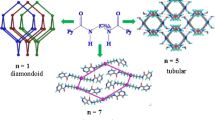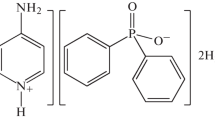Abstract
The three title compounds show extensive hydrogen bonding networks in the solid state. The structure of diphenyl-2-isopropylimidazol-4(5)yl phosphane oxide (3) is dominated by N–H⋯OP hydrogen bonds, whereas in bis(2-isopropylimidazol-4(5)-yl)phenyl- (2) and tris(2-isopropylimidazol-4(5)yl)phosphane oxide (1) both, N–H⋯N and N–H⋯OP hydrogen bonds determine the solid-state structures. Compound 1 crystallises in the monoclinic space group Cc with cell parameters a = 19.5447(6) Å, b = 10.45764(16) Å, c = 10.8549(3) Å and β = 121.418(4)°; 2 in the orthorhombic space group Pna21, with a = 11.5997(3) Å, b = 9.5836(2) Å, c = 16.1860(4) Å and 3 in the orthorhombic space group Pca21, with a = 10.8430(2) Å, b = 10.9277(2) Å and c = 27.7088(6) Å.
Graphical Abstract
Phosphane oxide compounds with isopropylimidazol-4(5)yl substituents show extensive hydrogen bonding networks in the solid state. The structure of diphenyl-2-isopropylimidazol-4(5)yl phosphane oxide is dominated by N–H⋯OP hydrogen bonds, whereas in bis(2-isopropylimidazol-4(5)-yl)phenyl- and tris(2-isopropylimidazol-4(5)yl)phosphane oxide both, N–H⋯N and N–H⋯OP hydrogen bonds determine the solid-state structures.









Similar content being viewed by others
References
Kunz PC, Zribi A, Frank W, Kläui W (2007) Z Anorg Allg Chem 633:955–960
Kunz PC, Zribi A, Frank W, Kläui W (2007) Z Anorg Allg Chem 634:724–729
Kunz PC, Kassack MU, Hamacher A, Spingler B (2009) Dalton Trans 7741–7747
Bell R, Lock C, Scholten C, Valliant J (1998) Inorg Chim Acta 274:137–142
Kunz PC, Huber W, Rojas A, Schatzschneider U, Spingler B (2009) Eur J Inorg Chem 5358–5366
Kunz PC, Kläui W (2008) Collect Czech Chem Commun 72:492–502
Kunz PC, Reiß GJ, Frank W, Kläui W (2003) Eur J Inorg Chem 3945–3951
Tolmachev AA, Yurchenko AA, Merkulov AS, Semenova MG, Zarudnitskii EV, Ivanov VV, Pinchuk AM (1999) Heteroat Chem 10:585–597
Oshovskii GV, Tolmachev AA, Yurchenko AA, Merkulov AS, Pinchuk AM (1999) Russ Chem Bull 48:1341–1347
Strasser CE, Gabrielli WF, Schuster O, Nogai SD, Cronje S, Raubenheimer HG (2009) J Chem Crystallogr 39:478–483
Yurchenko AA, Huryeva AN, Zarudnitskii EV, Marchenko AP, Koidan GN, Pinchuk AM (2009) Heteroat Chem 20:289–308
CrysAlisPro (2007) Software system v 171.32. Oxford Diffraction Ltd., Oxford
Altomare A, Burla MC, Camalli M, Cascarano GL, Giacovazzo C, Guagliardi A, Moliterni AGG, Polidori G, Spagna R (1999) J Appl Cryst 32:115–119
Sheldrick GM (2008) Acta Cryst A64:112–122
Spek AL (2003) J Appl Cryst 36:7–13
Al-Farhan K (1992) J Crystallogr Spectrosc Res 22:687–689
Héroux A, Brisse F (1997) Acta Cryst C53:1318–1320
Lariucci C (1986) Acta Cryst C42:1825–1828
Ziemer B, Rabis A, Steinberger H (2000) Acta Cryst C56:e58–e59
Dunne B, Orpen A (1991) Acta Cryst C47:345–347
Dance I, Scudder M (1995) J Chem Soc Chem Commun 1039–1040
Etter MC, MacDonald JC (1990) Acta Cryst B46:256–262
Author information
Authors and Affiliations
Corresponding author
Rights and permissions
About this article
Cite this article
Kunz, P.C., Huber, W. & Spingler, B. NH⋯O and NH⋯N Hydrogen Bonded Networks in Imidazole-Based Phosphane Oxides: Structures of Tris(2-Isopropylimidazol-4(5)-yl)Phosphane Oxide, Bis(2-Isopropylimidazol-4(5)-yl)Phosphane Oxide and Diphenyl-2-Isopropylimidazol-4(5)-yl Phosphane Oxide. J Chem Crystallogr 41, 105–110 (2011). https://doi.org/10.1007/s10870-010-9845-0
Received:
Accepted:
Published:
Issue Date:
DOI: https://doi.org/10.1007/s10870-010-9845-0




